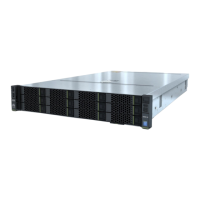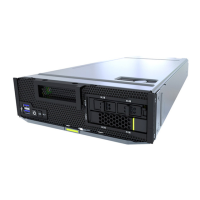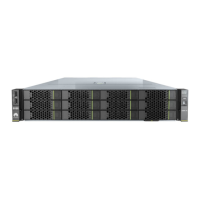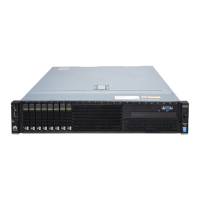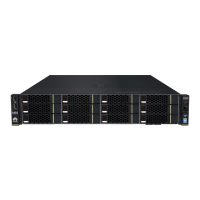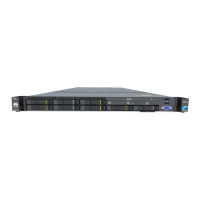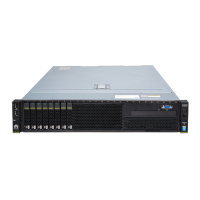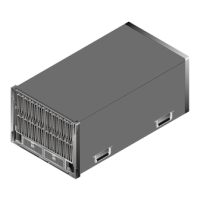Do you have a question about the Huawei FusionServer Pro XH321 V5 and is the answer not in the manual?
Explains the objective, scope, and intended audience of the maintenance and service guide.
Identifies the target readers for the FusionServer Pro XH321 V5 Maintenance and Service Guide.
Defines the meaning of symbols used throughout the document for hazard identification and notes.
Provides a general introduction to the XH321 V5 server node, its features, and ideal applications.
Details the physical layout, components, and external view of the XH321 V5 server node.
Illustrates the internal architecture, interconnections, and data flow of the XH321 V5 server.
Describes the front panel components, including PCIe cards, slide-out label plate, indicators, and buttons.
Details processor support, installation in socket CPU1, and heat sink requirements based on power.
Covers memory module identification, subsystem architecture, compatibility, and installation guidelines.
Explains drive configurations, numbering, and RAID controller card capabilities.
Details the PCIe slots, their specifications, and I/O expansion capabilities.
Provides a diagram and list of components on the XH321 V5 mainboard.
Lists key technical details including form factor, chipset, processors, memory, storage, network, and video.
Outlines operating temperature, humidity, altitude, and contaminant limits for server deployment.
Provides the physical dimensions, weight, and power consumption of the server node.
Covers compliance with laws, safety instructions, qualified personnel, and personal protective equipment.
Details measures to prevent electrostatic discharge damage and proper grounding techniques.
Addresses safe handling of equipment, power cables, and precautions during transportation.
Illustrates the signal cable connections for the Trusted Platform Module (TPM).
Details the signal cable connections for screw-in RAID controller cards.
Describes signal cable connections for PCIe cards, specifically for SP380 NICs.
Classifies spare parts (RSP, NRSP) and lists essential tools for maintenance.
Covers procedures for powering on, powering off, and forcibly powering off the server node.
Step-by-step guide for safely removing and installing the XH321 V5 server node from/to the chassis.
Detailed procedures for removing and installing key components like M.2 SSDs, processors, and memory.
Provides methods to find the iBMC management network port IP address via BIOS, WebUI, or CLI.
Guides users on accessing the iBMC web interface for server management and configuration.
Details methods for logging into the server desktop using Remote Virtual Console (Java/HTML5).
Explains how to log in to the server's command-line interface using PuTTY over network or serial port.
Covers the procedures for enabling and disabling the VMD function in the BIOS settings.
Provides step-by-step instructions to access the BIOS setup utility for configuration.
Describes the iBMC system, its features, management interfaces, and functions for remote server management.
Explains the role of BIOS, its data storage, POST process, and configuration capabilities.
Explains how to locate and interpret the serial number (SN) on the device's slide-out label plate.
Details maximum operating temperatures based on drive backplane, CPU power, and module configurations.
Lists and describes various RAS features supported by the server for enhanced system reliability.
Explains the objective, scope, and intended audience of the maintenance and service guide.
Identifies the target readers for the FusionServer Pro XH321 V5 Maintenance and Service Guide.
Defines the meaning of symbols used throughout the document for hazard identification and notes.
Provides a general introduction to the XH321 V5 server node, its features, and ideal applications.
Details the physical layout, components, and external view of the XH321 V5 server node.
Illustrates the internal architecture, interconnections, and data flow of the XH321 V5 server.
Describes the front panel components, including PCIe cards, slide-out label plate, indicators, and buttons.
Details processor support, installation in socket CPU1, and heat sink requirements based on power.
Covers memory module identification, subsystem architecture, compatibility, and installation guidelines.
Explains drive configurations, numbering, and RAID controller card capabilities.
Details the PCIe slots, their specifications, and I/O expansion capabilities.
Provides a diagram and list of components on the XH321 V5 mainboard.
Lists key technical details including form factor, chipset, processors, memory, storage, network, and video.
Outlines operating temperature, humidity, altitude, and contaminant limits for server deployment.
Provides the physical dimensions, weight, and power consumption of the server node.
Covers compliance with laws, safety instructions, qualified personnel, and personal protective equipment.
Details measures to prevent electrostatic discharge damage and proper grounding techniques.
Addresses safe handling of equipment, power cables, and precautions during transportation.
Illustrates the signal cable connections for the Trusted Platform Module (TPM).
Details the signal cable connections for screw-in RAID controller cards.
Describes signal cable connections for PCIe cards, specifically for SP380 NICs.
Classifies spare parts (RSP, NRSP) and lists essential tools for maintenance.
Covers procedures for powering on, powering off, and forcibly powering off the server node.
Step-by-step guide for safely removing and installing the XH321 V5 server node from/to the chassis.
Detailed procedures for removing and installing key components like M.2 SSDs, processors, and memory.
Provides methods to find the iBMC management network port IP address via BIOS, WebUI, or CLI.
Guides users on accessing the iBMC web interface for server management and configuration.
Details methods for logging into the server desktop using Remote Virtual Console (Java/HTML5).
Explains how to log in to the server's command-line interface using PuTTY over network or serial port.
Covers the procedures for enabling and disabling the VMD function in the BIOS settings.
Provides step-by-step instructions to access the BIOS setup utility for configuration.
Describes the iBMC system, its features, management interfaces, and functions for remote server management.
Explains the role of BIOS, its data storage, POST process, and configuration capabilities.
Explains how to locate and interpret the serial number (SN) on the device's slide-out label plate.
Details maximum operating temperatures based on drive backplane, CPU power, and module configurations.
Lists and describes various RAS features supported by the server for enhanced system reliability.
